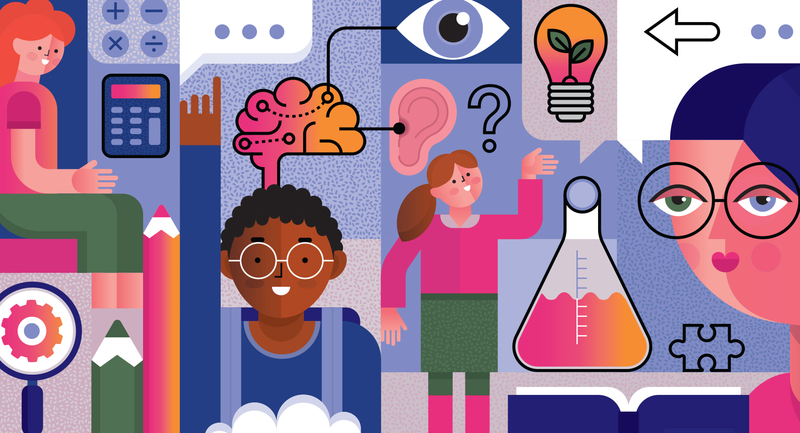Since the early 1980s, the United States has been engaged in the most intensive school reform effort in its history. Billions of dollars have been spent; hundreds of blue-ribbon committees and study groups have analyzed and reported; countless conferences have been held; and a plethora of programs, laws, and regulations have generated enormous amounts of churning at the fringes of our education system.
But despite all this activity, even the most ardent reformers must admit that public schools and student learning have improved only slightly, if at all.
Our middle schools and high schools fail in their mission with at least two-thirds of their students—the one-third who drop out of high school and the one-third who earn a diploma but who are unprepared either for college or the modern workplace. Breaking large schools into smaller academies and widely publicized "turnaround" schools have generally not succeeded.
After so much effort, why have we accomplished so little?
Despite the universal rhetoric about the importance of public education and the urgent need to improve schools, the vast majority of parents, opinion leaders, and the public accept most of the existing system as a given. They cannot imagine schools that are much different from those they attended, and they are unwilling or unable to challenge the major assumptions on which our education system is based.
Standardization: The Assumption That Locks In Failure
One harmful assumption many education policymakers make is that we can close the persistent achievement gap between minority and white students—a gap that stems in large part from an array of deeply entrenched socioeconomic problems—by holding all students to the same high content standards; moving them sequentially through a common, rigorous curriculum organized into academic silos; giving them little or no say in their own education; and requiring them to take standardized, high-stakes tests virtually every year. Harvard Business School professor Clayton Christensen strenuously disagrees with this assumption. In Disrupting Class: How Disruptive Innovation Will Change the Way the World Learns, he and his colleagues write,
The current educational system—the way it trains teachers, the way it groups students, the way the curriculum is designed, and the way the school buildings are laid out—is designed for standardization. If the nation is serious about leaving no child behind, it cannot be done by standardized methods. (Christensen, Horn, & Johnson, 2008, pp. 37–38)
In a medical system that operated as our education system does, a doctor would announce to his waiting patients, "It's Monday afternoon, so everyone will get a shot of penicillin."
Standards are essential, but contrary to the conventional wisdom, standards don't educate kids; they simply provide a framework of knowledge that experts deem to be essential for everyone, and they are worth little if we lack the processes and resources to achieve them.
Standardized tests do not measure the kinds of learning and other accomplishments that parents and society value. And these tests are often biased and unfair.
To force every student to study higher-order math, whether or not elementary and middle school prepared them for it or whether or not they will ever use it in life after school, is cruel and unusual punishment and a waste of time and resources. Advocates rationalize this requirement as a way of producing scientists and engineers to keep the United States competitive in the global marketplace. But that's like assuming that a couple of courses in high school art will produce artists.
Prominent educator and researcher John Goodlad (2009) is so concerned about the emphasis on standardization that he recently wrote,
Over a period of 60 years, I have taught in a one-room school and a school for delinquent boys, taught in every grade from the first through graduate school, been a dean for 16 years, and studied in depth and breadth educational change, schooling, the education of educators, and more. I now look back in wonderment, anger, and near despair at the stark reality of we the people scarcely murmuring for eight years over the imposition of the No Child Left Behind Act on our public schools. No powerful intellect is required for coming to the conclusion that we the people are grossly undereducated in what education is and negligent in the informed care of our irreplaceable asset, the public school.
I can't claim Goodlad's experience or wisdom, but having spent the past 25 years immersed in the issues of public education, I share his wonderment, anger, and despair. And I have reluctantly concluded that we cannot get the schools we need just by improving the ones we have. Our challenge is not to reform schools, but to redesign them.
Schools are the institutions that society created to educate all its children— not just those who are white, affluent, and compliant. If existing traditional schools cannot do the job, then we must create new institutions that can.
The standards-based accountability of the past 20 years has not closed the achievement gap or improved student learning. We need to continue doing everything possible to transform conventional schools because they will enroll the vast majority of our young people for many years to come. But simultaneously, we must pursue a second strategy to create new, innovative schools.
These new schools—mainly middle and high schools—should be different from traditional schools and from one another, and they should be based on assumptions that are radically different from those now widely held. Paramount among these new assumptions is that the student must come first and that every child deserves a personalized education.
Personalization Is the Key
The outlines of a new strategy began to take shape more than two decades ago with the creation of dozens of innovative schools and the establishment of the United States' first charter school in St. Paul, Minnesota. Some 40 states and the District of Columbia now have chartering laws under which about 4,600 charter schools enroll about 1,500,000 students (Center for Education Reform, 2009). In addition, major urban districts, such as New York, Chicago, Milwaukee, and Philadelphia, are contracting with education entrepreneurs to start new schools. Not all these new schools are innovative or successful, but many are. And their numbers are growing.
Personalization is key because it shapes virtually every aspect of a school. Personalized schools must be relatively small so that students and teachers know one another well. Because standardization is the antithesis of personalization, such schools don't have a traditional core curriculum with typical academic courses and rigid schedules. Students play a significant role in designing their own curriculums, which usually emphasize real-world learning. Teachers become advisors who guide students in educating themselves, tutor them, and help them manage their time and energy. Student learning is assessed on the basis of actual work, as demonstrated in portfolios, exhibitions, special projects, experiments, recitals, and performances—real accomplishments rather than abstract test scores.
Unlike traditional schools, personalized schools accommodate the enormous diversity of today's students, recognizing that they come from different socioeconomic situations and cultural backgrounds, learn in different ways and at different speeds, and have different talents, problems, and aspirations. These schools offer a variety of educational opportunities to match student diversity. And they tend to serve those youngsters who are least well served by the conventional system.
Personalized education is not just a theory. It's a reality being carried out successfully every day in hundreds of schools across the United States. Three examples follow.
Real-World Experience at the Met
No school that I know of carries the concept of personalized learning as far as the Met, with which I've been associated for more than a decade. The Metropolitan Regional Career and Technical Center is a state-funded high school district in Rhode Island that serves about 700 students in six schools on three campuses—two in Providence and one in Newport. Like all public schools, the Met accepts all the applicants it can accommodate; it uses a lottery if the number of applicants exceeds the number of spaces.
The Met employs no common curriculum, no rigid schedule, and no sequence of classes. Teachers are called advisors; each works with the same 15 students for four years. The core of the school is the annual, yearlong Learning Through Internship. Each student designs his or her own personal curriculum in consultation with advisors, a parent, and a mentor. (Since 1996, more than 1,000 adults in the community have mentored Met students.) The learning plan includes special projects and research. Students spend two days a week interning with a company or organization in the community under the supervision of the workplace mentor. Students intern in a wide variety of workplace sites, including law firms, hospitals, government agencies, restaurants, art galleries, and factories. These internships enable students to develop knowledge in a variety of disciplines.
To receive a Met diploma, each student is required to complete a senior project and a 75-page autobiography. At the school's first commencement ceremony, an advisor presented a diploma to a lanky, handsome young man and told the audience, "Hector insisted he could never graduate because he could never meet the requirement of writing a 75-page autobiography. Well, he turned in his paper last week, and it was 100 pages. And he said to me, 'Thanks for making me write that, because until I did, I didn't know who I was.'"
For her senior project, one student wrote a play. Because her advisor and peers thought it was excellent, she decided to produce it. She cast it, directed it, acted in it, rented a small theater for two nights in a nearby town, and had posters and tickets printed.
Two young women decided to retrace the march led by Martin Luther King Jr. in 1965 from Selma to Montgomery, Alabama. They prepared for weeks reading books and newspapers of the time. They stayed with families along the way and talked with people who had made the march. Later, when asked what lessons they learned, one of the students replied, "I learned that people died so I can vote, so I'll never miss a vote."
The Met's significant involvement in the real world is based on the conviction that students will remember and be better able to apply knowledge they gain through authentic experiences. Met cofounder Elliot Washor points out that conventional schools operate on the premise of text to life—delivering abstract knowledge (mostly factual information) from books and instructors and then trying to apply it later in real life. In contrast, Met students learn in real-life situations and then turn to texts because they want to know more.
Well over 90 percent of Met graduates attend two-year and four-year colleges. Students' interest in college results in part from the fact that many take college courses while still in high school. The Met has so many students taking courses at Rhode Island Community College that the school has placed a staff member on the college campus to counsel and work with students. Students also take courses at Brown University, Rhode Island College, Johnson and Wales University, and other nearby institutions.
Student-Designed Projects at New Country School
Project-based learning is the heart of New Country School, a public charter school for grades 6–12 in Henderson, Minnesota. Of its 106 students, 38 percent have special needs, and 23 percent qualify for free and reduced-price lunch. The school maintains no set curriculum except a math block, a reading hour, and a painting class with an artist in residence. There is no principal; the 21 staff members run the school. There are no traditional classrooms; each student has a workplace in an office-like setting. (New Country describes itself as a one-room school.) Every student has a computer, but books are everywhere. Students work alone, in groups, or one-on-one with their advisors.
Students spend most of their time at work stations in the large atrium, but the school also has a science room with lab equipment, an art studio, a greenhouse, a wood shop, a mechanics/metal shop, and a conference room.
Students devote more than one-half of each school day to interdisciplinary projects; they design each project themselves and submit a project proposal for faculty approval. The proposal describes in detail what the student wants to learn, how he or she plans to do so, and how the project intersects with state standards. The student has to justify his or her project as a legitimate learning experience, show its value to the community, and estimate how many credits it is worth. Students keep a daily log of how they spend their time. Like Met students, New Country students work with community experts who evaluate them on their performance. Students also evaluate themselves, using a performance rubric to rate their work in three areas: critical thinking, leadership and innovation, and their performance on specific projects.
The array of projects at New Country is broad and rich; each one is an adventure in learning across disciplines. For his senior project, one student explored optics, including holography and photography. Part of the project involved creating two videos that he posted on YouTube on how to make your own holograms.
Another student, who was interested in ancient Egypt, wanted to know more about how and why Egyptians mummified their leaders. He read extensively about Egyptian culture and set out to mummify a chicken, which required learning chemical and other processes used centuries ago.
Three-quarters of New Country graduates go on to postsecondary education. One-quarter take college courses during their high school years through Minnesota's postsecondary enrollment program.
Inquiry at Urban Academy
Urban Academy Laboratory High School was established in 1985 as one of New York City's alternative high schools. Its 14 teachers work with 120 students, most of them minority and economically disadvantaged. In some ways, Urban Academy appears to be closer to the conventional school model than the other schools described here. It has a defined curriculum and schedule, offering courses in math, history, literature, and a variety of interdisciplinary courses. Many courses are designed by faculty to focus on key concepts or essential skills.
What makes Urban Academy different from typical high schools is its emphasis on inquiry. Inquiry-based learning means asking hard questions as a path to rigorous thinking. And that is what happens in every class.
The goal of such questioning and debate is to develop critical-analysis and problem-solving skills—to help students become lifelong learners. Students learn to gather information through research and reading, analyze it, assess it, take a stand on it, present it articulately, and defend it in open discussion.
Assessment at Urban Academy is performance based. Students earn their diplomas by showing what they've learned, what they've accomplished, and how they've grown. To graduate, students must demonstrate proficiency in creative arts, criticism, literature, mathematics, social studies, and science. For example, to demonstrate creative arts proficiency, one student made a film that portrays the experiences of black girls. She interviewed a number of young women and built the film around their stories. Her film, A Girl Like Me, has won numerous awards and was selected for the 2006 Tribeca Film Festival.
At the beginning of each semester, Urban Academy students participate in a two- or three-week schoolwide project. Fall projects are based on provocative questions, such as Do elections matter? New York City offers a wealth of educational opportunities, and Urban Academy's projects take students out into the city to explore issues related to these questions. Students and staff meet in small groups to explore issues related to the question; at the end of the project, each group presents what it has learned and done to the whole school. Spring projects usually relate to arts and crafts and include research into interesting subjects.
More than 95 percent of Urban Academy graduates go on to four-year colleges. At least one-half of the school's students take a college course at institutions like New College and Hunter College while still in high school.
An Approach Whose Time Has Come
These three schools and others like them are succeeding, usually with the most disadvantaged youngsters. A much higher than average percentage of their graduates enroll in postsecondary programs—often, these young people are the first in their families to graduate from high school, let alone attend college. But to appreciate the power of personalizing education, one has only to spend time with the students—listen to their stories, engage them in conversation, and see how motivated and confident they are.
The philosophy of personalized education is spreading. With major funding from the Bill and Melinda Gates Foundation, the Met and New Country models have been scaled up. Big Picture Learning, which designed and established the Met, currently has a network of more than 70 schools in the United States and abroad. EdVisions, creator of New Country School, has established nearly 50 schools with the same structure and philosophy.
Many school districts publish mission statements. The best of these statements include such objectives as creating lifelong learners, developing the personal values students need to negotiate the ethical and moral dilemmas of life, and providing students with the skills to be productive workers in a rapidly changing economy and responsible citizens in a democracy.
These are worthy objectives, essential to individual fulfillment and the welfare of the larger society. If we agree that these are indeed the main goals of education, then we must look deeply and critically at the assumptions and premises on which our schools are organized and operated to see whether they align with the goals. If they do not, then we must discard them.
We will know we've succeeded when society thinks of conventional schools as the "alternative" schools.








